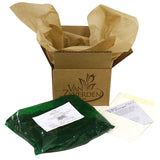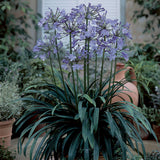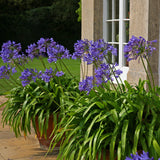PRESALE
Spring 2025 Shipping Schedule: 2/28/2025
Agapanthus is an evergreen perennial commonly called Lily of the Nile but is actually from South Africa. Agapanthus produces large flower clusters resembling allium on tall stalks arising from a mound of strap-shaped leaves. Can be planted in the garden in the warmer parts of the U.S.A. Best grown in containers and protected from winter conditions in more northern locations.
About this Variety
Large, showy, blue spherical flower heads that arise on tall stems with strap-like foliage.
Highlights
- Great for patio containers
- Large, showy blooms
- Excellent for cut flowers
- Drought tolerant once established
- Grows well in garden beds and borders in warm climates
Exposure:
Full sun to partial shade
Blooms:
Summer
Height:
Grows 24-48" tall
Spacing/Depth:
Plant 12-24" apart, 1-2" deep
USDA Zones:
Grow as Perennial in zones 8-11. Grow as Annual elsewhere.
Growing Instructions
Plant Agapanthus in the spring after all danger of frost has passed. Agapanthus prefers full sun to partially shaded locations. The ideal soil is rich and porous and drains well, yet still holds enough water for the roots. If your soil is heavy clay and drains slowly, or very sandy and does not hold water, add organic soil amendments like peat moss or ground bark. Spread a 3-4 inch layer of soil amendment if needed and incorporate into the soil to a depth of 10 inches. Plant rhizomes 1-2" deep and 12-24" apart. Cover with soil. When planting a large number of Agapanthus in one bed, excavate the entire area to the recommended depth, work fertilizer into the bottom of the trench, set out rhizomes and then cover all at once. Water thoroughly at planting. While actively growing, water frequently and thoroughly so that water will reach roots. Mulch to keep the soil cool and to prevent the soil from drying out. Fertilize regularly. Let plant dry during dormancy. Divide if necessary every 3-6 years.
Care Tip
Agapanthus is best grown in containers and protected from winter conditions in more northern locations. Can be planted in the garden in warmer climates.


















